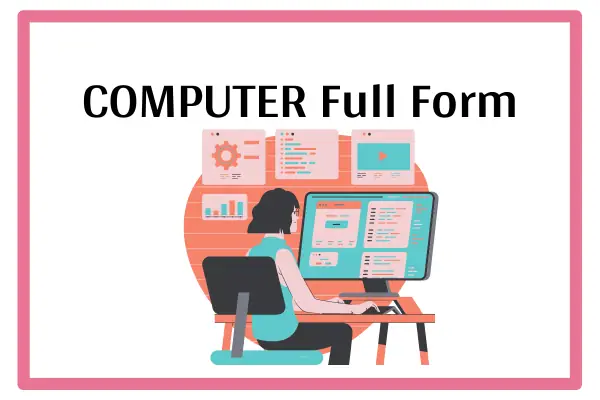The full form of a Computer is a “Common Operating Machine Used for Technological and Educational Research.” The term was coined during the middle of the 20th century when the first computers were developed. Initially, computers were utilized for scientific and military investigation, but as time progressed, their application expanded. The term ‘computer’ was given to these devices to signify their purpose, which was to compute and process vast quantities of data.

Computer Full Form
Computers have become an integral component of our daily lives in the modern world. Computers are used for a variety of purposes, including work, recreation, communication, and education. Numerous times we have heard the term ‘computer,’ but have we ever considered what it means? This article will examine the complete meaning of the word ‘computer’ and explain how it operates.
How do computers operate?
A computer is an electronic device that functions according to a set of instructions known as software. The computer hardware includes the Central Processing Unit (CPU), Random Access Memory (RAM), Hard Disk Drive (HDD), and Input/Output (I/O) devices. When a user inputs an instruction, the CPU processes it and retrieves the necessary data from RAM or the hard drive. The output is then displayed on-screen or audibly via a speaker.
Innovations in Information Technology
Since the invention of computers, advancements in computing technology have been enormous. The earliest computers were enormous, costly, and had limited capabilities. However, as time has passed, computers have become smaller, more affordable, and more effective. There are numerous types of computers available today, including laptops, workstations, tablets, and smartphones. Modern computers have substantially more computing power, allowing them to perform complex tasks such as Artificial Intelligence and Machine Learning.
Which computer categories exist?
The computer can be classified based on how it processes specific operations. The fundamental classes are as follows:
- Digital Computer
- Analog Computer
- Hybrid Computer
Computer Generations
First generation computer:-
From 1946 to 1954, the first generation of computers existed. The first generation of Computers utilized vacuum tubes, also known as electronic valves. The digital computer was the first iteration of computers.
Second-generation computer:-
The second generation spans the years 1955 through 1964. In a second-generation computer, a transistor replaced the vacuum tube. In second-generation computers, a Ferrite core was used for primary memory, and magnetic disks were used for secondary memory. Advanced vocabulary was utilized.
Third-generation computer:-
The third generation spans the years 1964 through 1977. The transistor was replaced with integrated circuit (IC) circuits. A single Integrated Circuit (IC) device can contain many transistors, registers, and capacitors.
Fourth-generation Computer:-
The fourth generation spans the years 1978 through 1990. The fourth generation utilized VLSI. VLSI is an acronym for very large-scale integration. VLSI refers to an Integrated Circuit Chip with over a thousand embedded components. In this era, personal computers were manufactured.
Fifth-generation computer:-
The fifth generation spans the years 1991 to the present. The fifth generation of ULSI processors debuted with obscurity. ULSI is an acronym for Ultra Large Scale Integration. New technologies such as AI (Artificial Intelligence) and Machine Learning are introduced in the fifth generation.
FAQ:
What is the full form of a Computer?
The full form of the Computer is Common Operating Machine Purposely Used for Technological and Educational Research.
What is the full form of RAM?
The full form of RAM is Random Access Memory.